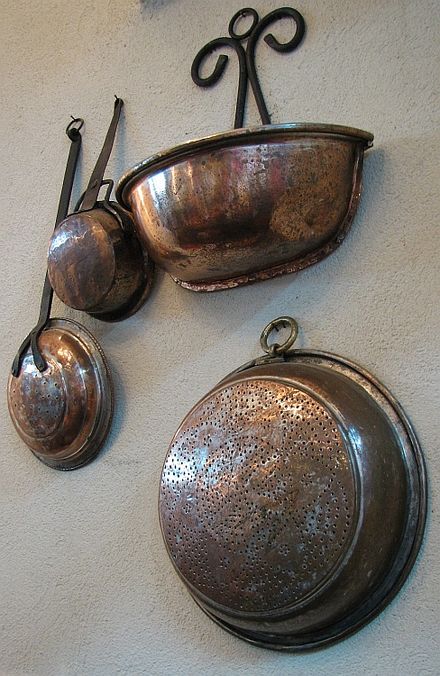|
Old copper utensils in a Jerusalem restaurant Copper has been used since ancient times as a durable, corrosion resistant, and weatherproof architectural material. Roofs, flashings, rain gutters, downspouts, domes, spires, vaults, and doors have been made from copper for hundreds or thousands of years. Copper's architectural use has been expanded in modern times to include interior and exterior wall cladding, building expansion joints, radio frequency shielding, and antimicrobial indoor products, such as attractive handrails, bathroom fixtures, and counter tops. Some of copper's other important benefits as an architectural material include its low thermal movement, light weight, lightning protection, and its recyclability. The metal's distinctive natural green patina has long been coveted by architects and designers. The final patina is a particularly durable layer that is highly resistant to atmospheric corrosion, thereby protecting the underlying metal against further weathering. It can be a mixture of carbonate and sulfate compounds in various amounts, depending upon environmental conditions such as sulfur-containing acid rain. Architectural copper and its alloys can also be 'finished' to embark a particular look, feel, and/or color. Finishes include mechanical surface treatments, chemical coloring, and coatings. Copper has excellent brazing and soldering properties and can be welded; the best results are obtained with gas metal arc welding. Antibiofouling applicationsCopper is biostatic, meaning bacteria will not grow on it. For this reason it has long been used to line parts of ships to protect against barnacles and mussels. It was originally used pure, but has since been superseded by Muntz metal. Similarly, as discussed in copper alloys in aquaculture, copper alloys have become important netting materials in the aquaculture industry because they are antimicrobial and prevent biofouling, even in extreme conditions and have strong structural and corrosion-resistant properties in marine environments. Antimicrobial applicationsNumerous antimicrobial efficacy studies have been conducted in the past 10 years regarding copper's efficacy to destroy a wide range of bacteria, as well asinfluenza A virus, adenovirus, and fungi. Copper-alloy touch surfaces have natural intrinsic properties to destroy a wide range of microorganisms (e.g., E. coli O157:H7, methicillin-resistant Staphylococcus aureus (MRSA), Staphylococcus, Clostridium difficile, influenza A virus, adenovirus, and fungi). Some 355 copper alloys were proven to kill more than 99.9% of disease-causing bacteria within just two hours when cleaned regularly. The United States Environmental Protection Agency (EPA) has approved the registrations of these copper alloys as "antimicrobial materials with public health benefits, which allows manufacturers to legally make claims as to the positive public health benefits of products made with registered antimicrobial copper alloys. In addition, the EPA has approved a long list of antimicrobial copper products made from these alloys, such as bedrails,handrails, over-bed tables, sinks, faucets, door knobs, toilet hardware, computer keyboards, health club equipment, shopping cart handles, etc. (for a comprehensive list of products, see: Antimicrobial copper-alloy touch surfaces#Approved products). Copper doorknobs are used by hospitals to reduce the transfer of disease, and Legionnaires' disease is suppressed by copper tubing in plumbing systems. Antimicrobial copper alloy products are now being installed in healthcare facilities in the U.K., Ireland, Japan, Korea, France, Denmark, Brazil and in the subway transit system in Santiago, Chile, where copper-zinc alloy handrails will be installed in some 30 stations between 2011–2014. Folk medicineCopper is commonly used in jewelry, and folklore says that copper bracelets relieve arthritis symptoms. In alternative medicine, some proponents speculate that excess copper absorbed through the skin can treat some ailments, or that the copper somehow creates a magnetic field, treating nearby tissue. In various studies, though, no difference is found between arthritis treated with a copper bracelet, magnetic bracelet, or placebo bracelet. As far as medical science is concerned, wearing copper has no known benefit, for any medical condition at all. A human being can have a dietary copper deficiency, but this is very rare, because copper is present in many common foods, includinglegumes (beans), grains, and nuts. There is no evidence that copper even can be absorbed through the skin. But if it were, this could actually lead to copper poisoning, which may actually be more likely than beneficial effects. Compression clothingMore recently, some compression clothing has been sold with copper woven into it, with the same folk medicine claims being made. While compression clothing is a real treatment for some ailments, therefore the clothing may appear to work, the added copper may very well have no benefit beyond a placebo effect. Other usesCopper compounds in liquid form are used as a wood preservative, particularly in treating original portion of structures during restoration of damage due to dry rot. Together with zinc, copper wires may be placed over non-conductive roofing materials to discourage the growth of moss. Textile fibers use copper to create antimicrobial protective fabrics, as do ceramic glazes,stained glass and musical instruments. Electroplating commonly uses copper as a base for other metals such as nickel. Copper is one of three metals, along with lead and silver, used in a museum materials testing procedure called the Oddy test. In this procedure, copper is used to detect chlorides, oxides, and sulfur compounds. Copper is used as the printing plate in etching, engraving and other forms ofintaglio (printmaking) printmaking. Copper oxide and carbonate is used in glassmaking and in ceramic glazes to impart green and brown colors. Copper is the principal alloying metal in some sterling silver and gold alloys. It may also be used on its own, or as a constituent of brass, bronze, gilding metaland many other base metal alloys.
|


Nenhum comentário:
Postar um comentário
Observação: somente um membro deste blog pode postar um comentário.